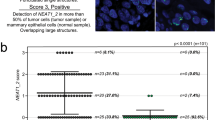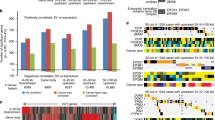Abstract
The 13q21 tumor suppressor locus, as defined by chromosomal deletion, harbors the KLF5 transcription factor which may have tumor suppressor function. To investigate whether KLF5 plays a role in breast cancer, we evaluated all genes and/or expressed sequence tags (ESTs) within a 3.3 Mb common region of deletion at 13q21. Of these, only KLF5 mRNA was expressed at high levels in non-neoplastic breast epithelial cells and in normal human mammary tissue, but at lower levels in various breast cancer cell lines. Using the real time TaqMan PCR assay, hemizygous deletion at KLF5 was detected in 13 out of 30, or 43% of breast cancer cell lines tested, and various degrees of loss of expression were detected in 21 out of 30, or 70% of these cell lines. Each of the cases with hemizygous deletion also exhibited loss of KLF5 expression, suggesting that loss of expression can result from chromosomal deletion, and that KLF5 may undergo haploinsufficiency during carcinogenesis. Only one of the 30 breast cancer cell lines tested exhibited a mutation in KLF5, and neither promoter methylation nor homozygous deletion was detected in any of the cell lines. In contrast, loss of heterozygosity (LOH) was frequently detected at KLF5. Re-expression of wild-type KLF5 in T-47D breast cancer cells significantly inhibited colony formation in these cells. Of the KLF5-transfected clones that did form colonies, none were found to express KLF5 mRNA. These findings suggest that loss of function by deletion and/or loss of expression frequently occurs at KLF5, and KLF5 suppresses tumor cell growth in breast cancer.
Oncogene (2002) 21, 6567–6572. doi:10.1038/sj.onc.1205817
This is a preview of subscription content, access via your institution
Access options
Subscribe to this journal
Receive 50 print issues and online access
$259.00 per year
only $5.18 per issue
Buy this article
- Purchase on Springer Link
- Instant access to full article PDF
Prices may be subject to local taxes which are calculated during checkout






Similar content being viewed by others
References
Black AR, Black JD, Azizkhan-Clifford J . 2001 J. Cell. Physiol. 188: 143–160
Chen C, Brabham WW, Stultz BG, Frierson HFJ, Barrett JC, Sawyers CL, Isaacs JT, Dong JT . 2001 Genes Chromosomes Cancer 31: 333–344
Conkright MD, Wani MA, Anderson KP, Lingrel JB . 1999 Nucleic Acids Res. 27: 1263–1270
Dang DT, Pevsner J, Wang VW . 2000 Int. J. Biochem. Cell Biol. 32: 1103–1121
Di Cristofano A, Pesce B, Cordon-Cardo C, Pandolfi PP . 1998 Nat. Genet. 19: 348–355
Dong JT, Chen C, Stultz BG, Isaacs JT, Frierson Jr HF . 2000 Cancer Res. 60: 3880–3883
Fero ML, Randel E, Gurley KE, Roberts JM, Kemp CJ . 1998 Nature 396: 177–180
Herman JG, Graff JR, Myohanen S, Nelkin BD, Baylin SB . 1996 Proc. Natl. Acad. Sci. USA 93: 9821–9826
Hyytinen ER, Frierson HF, Boyd JC, Chung LWK, Dong JT . 1999 Genes Chromosomes Cancer 25: 108–114
Kainu T, Juo SH, Desper R, Schaffer AA, Gillanders E, Rozenblum E, Freas-Lutz D, Weaver D, Stephan D, Bailey-Wilson J, Kallioniemi OP, Tirkkonen M, Syrjakoski K, Kuukasjarvi T, Koivisto P, Karhu R, Holli K, Arason A, Johannesdottir G, Bergthorsson JT, Johannsdottir H, Egilsson V, Barkardottir RB, Johannsson O, Haraldsson K, Sandberg T, Holmberg E, Gronberg H, Olsson H, Borg A, Vehmanen P, Eerola H, Heikkila P, Pyrhonen S, Nevanlinna H . 2000 Proc. Natl. Acad. Sci. USA 97: 9603–9608
Knuutila S, Aalto Y, Autio K, Bjorkqvist AM, El-Rifai W, Hemmer S, Huhta T, Kettunen E, Kiuru-Kuhlefelt S, Larramendy ML, Lushnikova T, Monni O, Pere H, Tapper J, Tarkkanen M, Varis A, Wasenius VM, Wolf M, Zhu Y . 1999 Am. J. Pathol. 155: 683–694
Knuutila S, Bjorkqvist AM, Autio K, Tarkkanen M, Wolf M, Monni O, Szymanska J, Larramendy ML, Tapper J, Pere H, El-Rifai W, Hemmer S, Wasenius VM, Vidgren V, Zhu Y . 1998 Am. J. Pathol. 152: 1107–1123
Narla G, Heath KE, Reeves HL, Li D, Giono LE, Kimmelman AC, Glucksman MJ, Narla J, Eng FJ, Chan AM, Ferrari AC, Martignetti JA, Friedman SL . 2001 Science 294: 2563–2566
Roylance R, Gorman P, Harris W, Liebmann R, Barnes D, Hanby A, Sheer D . 1999 Cancer Res. 59: 1433–1436
Rozenblum E, Vahteristo P, Sandberg T, Bergthorsson JT, Syrjakoski K, Weaver D, Haraldsson K, Johannsdottir HK, Vehmanen P, Nigam S, Golberger N, Robbins C, Pak E, Dutra A, Gillander E, Stephan DA, Bailey-Wilson J, Juo SH, Kainu T, Arason A, Barkardottir RB, Nevanlinna H, Borg A, Kallioniemi OP . 2002 Hum. Genet. 110: 111–121
Shi H, Zhang Z, Wang X, Liu S, Teng CT . 1999 Nucleic Acids Res. 27: 4807–4815
Tirkkonen M, Johannsson O, Agnarsson BA, Olsson H, Ingvarsson S, Karhu R, Tanner M, Isola J, Barkardottir RB, Borg A, Kallioniemi OP . 1997 Cancer Res. 57: 1222–1227
Ton-That H, Kaestner KH, Shields JM, Mahatanankoon CS, Yang VW . 1997 FEBS Lett. 419: 239–243
Acknowledgements
This study was supported in part by NIH grants CA85560 and CA87921 from the National Cancer Institute.
Author information
Authors and Affiliations
Corresponding author
Rights and permissions
About this article
Cite this article
Chen, C., Bhalala, H., Qiao, H. et al. A possible tumor suppressor role of the KLF5 transcription factor in human breast cancer. Oncogene 21, 6567–6572 (2002). https://doi.org/10.1038/sj.onc.1205817
Received:
Revised:
Accepted:
Published:
Issue Date:
DOI: https://doi.org/10.1038/sj.onc.1205817
Keywords
This article is cited by
-
Machine-learning analysis reveals an important role for negative selection in shaping cancer aneuploidy landscapes
Genome Biology (2024)
-
Integrative competing endogenous RNA network analyses identify novel lncRNA and genes implicated in metastatic breast cancer
Scientific Reports (2023)
-
A human-specific insertion promotes cell proliferation and migration by enhancing TBC1D8B expression
Science China Life Sciences (2023)
-
TTK promotes mesenchymal signaling via multiple mechanisms in triple negative breast cancer
Oncogenesis (2018)
-
KLF5 promotes cervical cancer proliferation, migration and invasion in a manner partly dependent on TNFRSF11a expression
Scientific Reports (2017)



